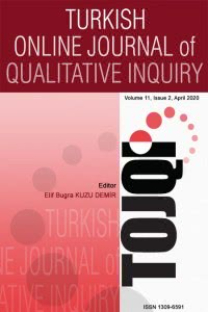Yansıtıcı Düşünme Odaklı Bir Çevrimiçi Ortamın Oluşturulması ve Etkililiğinin İncelenmesi1
Bu çalışma yansıtıcı düşünme becerilerini harekete geçirecek, becerilerin kullanılmasını ve geliştirilmesini sağlayacak bir çevrimiçi ortam oluşturmak ve bu ortamın etkililiğini incelemek üzere gerçekleştirilmiştir. Sınıf yönetimi ders içeriğine göre hazırlanan bu araştırmada nicel ve nitel yöntemlerin birlikte kullanıldığı karma desenlerden açımlayıcı sıralı desen kullanılmıştır. Uygulama sürecine başlamadan önce 12 üniversite öğrencisi ile araştırmanın pilot uygulaması gerçekleştirilmiştir. Pilot uygulama sonuçlarına göre çevrimiçi ortamın öğrencilerin yansıtıcı düşünebilme becerilerini geliştirebileceğine dair ipuçları elde edilmiştir. Pilot uygulama sonunda öğrencilerden alınan görüşler doğrultusunda çevrimiçi ortamda düzenlemeler yapılmış ve düzenlenen yeni çevrimiçi ortam, araştırmaya gönüllü katılan 30 üniversite öğrencisi üzerinde yeniden sınanmıştır. 30 öğrenciden toplanan nicel ve nitel veriler analiz edildiğinde çevrimiçi ortamın öğrencilerin yansıtıcı düşünebilme becerilerine katkı sağladığı sonucuna varılmıştır.
Developing a Reflective Thinking Focused Online Environment and Investigation Its' Effectiveness
This study has been carried out to develop an online environment that will trigger reflective thinking skills and that will enable the use and improvement of these skills. Sequential Explanatory Design, one of the mixed designs in which quantitative and qualitative methods are used together, has been used in this study prepared according to the curriculum of Class Management. Before starting the implementation process, a pilot scheme of the study with twelve university students has been carried out. According to the results of the pilot scheme, some clues showing that online environment may improve the reflective thinking skills of the students have been found. At the end of the pilot scheme, a few arrangements have been made online in the direction of the students' views and this new arranged online environment has been retested on the thirty volunteer university students. When the qualitative and quantitative results collected from the thirty volunteer students were analyzed, it was concluded that the online environment made a contribution to the reflective thinking skills of the students.
___
- Arkün, S. ve Erdem, M. (2007). BİT destekli öğretmen eğitimi modelleri üzerine bir inceleme. Uluslararası Öğretmen Yetiştirme Politikaları ve Sorunları Sempozyumu Bildiriler Kitabı içinde (ss.492-496), Bakü, Azerbaycan.
- Bain, J. D., Ballantyne, R., Mills, C. ve Lester, N. C. (2002). Reflecting on practice student teachers' perspectives. Flaxton, QLD: Post Pressed.
- Büyüköztürk, Ş. (2012). Sosyal bilimler için veri analizi el kitabı: istatistik, araştırma deseni SPSS uygulamaları ve yorum, (16. baskı), Ankara: Pegem Yayınları.
- Creswell, J. W. (2003). Research design: Qualitative, quantitative and mixed methods approaches (2. baskı), California, CA: Sage.
- Dewey, J. (1991). How we think. New York, NY: Prometheus Books.
- Erlandson, D. A., Harris, E. L., Skipper, B. L. ve Allen, S. T. (1993). Doing naturalistic inquiry: A guide to methods. Beverly Hills, CA: Sage.
- Hew, K. ve Cheung, W. (2008) Attracting student participation in asynchronous online discussions: Case study of peer facilitation. Computers & Education, 51, 1111-1124.
- Jonassen, D. (1999). Designing constructivist learning environments. In Ed. C. M. Reigeluth (Ed.) Instructional-Design theories and models içinde (ss.215-239). London: Lawrance Erlbaum Associates Publishers.
- Jones, O. (2000). Time to split, virtually: Expanding virtual publics into vibrant virtual metropolises. 33rd Hawaii International Conference on System Sciences [33. Hawaii Uluslararası Siste Bilimleri Konferansı] bildiri kitabı içinde. DOI: 10.1109/HICSS.2000.926810.
- Jorgensen, D. (2002). The challange sand benefits of asynchronous learning networks. Reference Librarian, 77 (1), 3-17.
- Lee, H. (2008). Students' perceptions of peer and self assessment in a highereducation online collaborative learning environment. (Yayımlanmamış doktora tezi). Texas Üniversitesi, Austin, ABD.
- Makoul, G., Zick, A. B., Aakhus, M., Neely, K. J. ve Roemer, P. E. (2010). Using an online forum to encourage reflection about difficult conversations in medicine. Patient Education and Counseling, 79 (1), 83-86.
- Mettiainen, S. ve Vahamaa, K. (2013). Does reflective web-based discussion strengthen nursing students'learning experiences during clinical training? Nurse Education in Practice, 13, 344-349.
- McNamara, J. ve Brown, C. (2008, Kasım). Assessment of collaborativelearning in online discussions. ATN Assessment Conference 2008 [2008 ATN Değerlendirme Konferansı]'nda sunulmuş bildiri. Güney Avusturalya Üniversitesi, Adelaide, Avusturalya.
- Nicholson, S. A. ve Bond, N. (2003). Collaborative reflecion and professional community building: An analysis of preservice teachers' use of an electronic disscussion board. Journal of Technology and Teacher Education, 1(2), 147-155.
- Onwuegbuzie, A. J. ve Leech, N. L. (2006). Linking research questions to mixed methods data analysis procedures. The Qualitative Report, 11(3), 474-498. http://www.nova.edu/ssss/QR/QR11-3/onwuegbuzie.pdf adresinden 20 Nisan 2013 tarihinde alınmıştır.
- Özçınar, H. (2011). Video-durumlarda yansıma noktalarının ve tartışma gruplarında öğretmen katılımının yansıtıcı düşünmeye etkisi. (Yayımlanmamış Doktora Tezi). Ankara Üniversitesi, Eğitim Bilimleri Enstitüsü, Ankara.
- Ramos Hernandez, P. (2004). Web logs and online discussions as tools to promote reflective practice. The Journal of Interactive Online Learning, 3(1), 1-16.
- Revill, G. ve Terrell, I. (2005). Learning in the workplace: A new degree online. Innovations in Education and Teaching International, 42(3), 231-245.
- Rodgers, C. (2002). Defining reflection: Another look at John Dewey and reflective thinking. Teachers College Record, 104(4), 842-866.
- Rugg, H. (1947). Foundations for American education. New York, NY: World Book Company.
- Salmon, G. (2002). E-tivities: The key to active online learning. London: KoganPage.
- Schön, D.A. (1983). The reflective practitioner: How professionals think in action. New York, NY: Basic Books.
- Taggart, G. L. ve Wilson, A. P. (2005). Promoting reflective thinking in teachers: 50 action strategies, (2. baskı), Thousand Oaks, London, New Delhi: Sage Publications.
- Ünver, G. (2003). Yansıtıcı düşünme. PegemA Yayıncılık, Ankara.
- ISSN: 1309-6591
- Başlangıç: 2010
- Yayıncı: Prof.Dr. Abdullah Kuzu
Sayıdaki Diğer Makaleler
Yansıtıcı Düşünme Odaklı Bir Çevrimiçi Ortamın Oluşturulması ve Etkililiğinin İncelenmesi1
Tansel TEPE, Naşide IŞIK, Kerem AY, MUKADDES ERDEM
Eddy HARYANTO, Rahmat MURBOYONO, Muazza MUAZZA, Meitia EKATİNA, Amirul MUKMİNİN
Eddy HARYANTO, Amirul MUKMİNİN, Rahmat MURBOYONO, Muazza MUAZZA, Meitia EKATİNA
The Stories of English Teachers as Learners in Terms of Teacher Socialization1
How Scholars Define the Field of Computer Education and Instructional Technology?1
ÖMER FARUK İSLİM, TUĞBA BAHÇEKAPILI ÖZDEMİR, Esra KARATAŞ CEVİZCİ, POLAT ŞENDURUR
Determination of the Relative Positions of Three Planes: Action Research
Okul Öncesi Öğretmen Adaylarının "Uygulama Öğretmeni" Kavramına İlişkin Zihinsel İmgeleri
